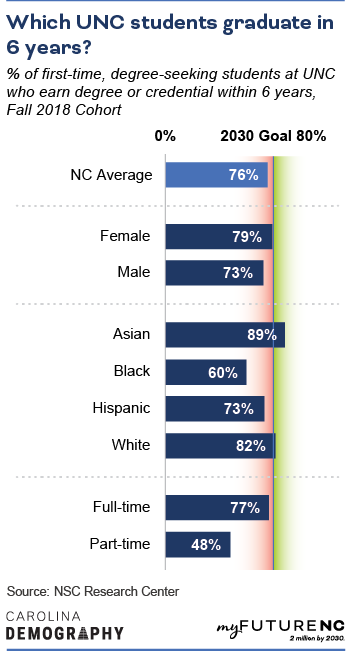Percentage of students beginning postsecondary at a North Carolina 4-year public institution who complete a degree or credential within 6 years
Data year: 2024
= Top southern state :
only available for totals, not available for all indicators
What does Postsecondary Completion Rate: 4-Year Public Institutions mean?
Percent of students beginning postsecondary education at a University of North Carolina (UNC) system school (4-year public institution) who complete a degree or credential from any institution within 6 years. These rates were updated for 2024, referring to students who began their college education in 2018.
What does this data show?
North Carolina’s postsecondary completion rate for students who began at a 4-year public institution was 76% in 2024, placing our state 8th among all states. In Florida, the state with the highest 4-year public postsecondary completion rate, and the top-performing Southern state, 82% of students beginning at a 4-year public university in 2018 earned a degree or credential within six years.
By 2030, the goal is to have 80% of students who begin postsecondary education at a UNC system school complete a degree or credential within six years. This goal was set by the myFutureNC Commission.
Why does Postsecondary Completion Rate: 4-Year Public Institutions matter?
The postsecondary completion rate represents the rate at which degree- or credential-seeking students complete their studies in a timely fashion. This is partly “a measure of the efficiency with which students complete college.” Specifically, high completion rates mean:
- more degree production, which is beneficial for economic competitiveness; and
- a smoothly functioning postsecondary system that can serve more students.
Lower completion rates are associated with costs to both individual students and the communities in which they live. Students who do not complete on time:
“experience costs in terms of receiving lower average earnings, having student debt, and losing time while enrolled in school. Additionally… students who fail to complete a college credential are less likely to go on to work in occupations that offer employment benefits (such as health insurance and pension plans), earn family-sustaining wages, or be civically involved.”
How is North Carolina performing?
Meeting the 2030 Goal
For North Carolina to meet its goal, an additional 1,254 students who begin postsecondary education in the UNC System need to complete a degree or credential within six years.
North Carolina’s postsecondary completion rate of 76% for 4-year public institutions means that more than three out of every four students who began their postsecondary studies at one of North Carolina’s public universities in the fall of 2018 completed a degree or credential by 2024. This completion rate was five percentage points above the national average (71%).

Which UNC students graduate in 6 years?
Trend
Students who began their postsecondary studies at a UNC System institution have consistently had higher postsecondary completion rates than the national average for public 4-year institutions. The North Carolina postsecondary completion rates for students who began their education in the UNC system have also increased over time: for the 2010 starting cohort (graduating by 2016) the rate was 71%, although down from a peak of 77% from 2020 to 2022, the rate for the 2018 starting cohort (graduation by 2024), was 76%, The national rate in 2024 was 71%.

By sex
Female students (79%) had higher completion rates than male students (73%).
By race/ethnicity
Asian students who began postsecondary education at a UNC System school had the highest completion rate: 89% completed a degree or credential within six years. White students (82%) had the next highest rate followed by Hispanic (73%) and Black (60%) students.
By enrollment status
Seventy-seven percent of UNC System students who were enrolled full-time completed a degree or credential within six years. In contrast, 48% of students enrolled part-time earned a degree within six years.
Methodology
Where does the data for postsecondary completion come from?
The data for completion rates by state was downloaded from the National Student Clearinghouse (NSC) Research Center.
The NSC is a nonprofit organization that provides postsecondary enrollment data and verification for more than 3,600 colleges and universities in the United States.
How was the data calculated?
This was a direct download from the NSC Research Center.
Who is included?
From NSC: “First-time-in-college degree-seeking students who started their postsecondary studies at U.S. colleges and universities in the fall of 2018.”
The NSC data includes transfer students.
Who isn’t included?
Non-first-time students (i.e. those who had previously enrolled at a college or university), non-degree-seeking students, students who began postsecondary education during summer or spring terms, and students who began postsecondary studies at an institution outside of the United States are not included. Full details on data exclusions are available here.
State-level data is not reported for states with fewer than three postsecondary institutions in a sector.
Collectively, the institutions covered by the NSC data serve 97% of all postsecondary students nationwide and 99% of students in North Carolina. The NSC data does not cover all institutional sectors equally. For instance, coverage rates are lower for for-profit institutions. More detail on NSC coverage is available here.
The data used in the development of this indicator is derived from administrative records and is subject to non-sampling error.
Learn more
Who is working on this in NC?
Help improve this section
If you know of an organization that is working on this topic in NC, please let us know on the feedback form.
NC-focused, state-level dashboards
Name: UNC System Dashboards
Website: https://www.northcarolina.edu/impact/stats-data-reports/
About: The UNC Data Dashboard is an interactive, online database that gives students, parents, policymakers and taxpayers expanded access to detailed system data on selected core measures.
Name: NC Tower
Website: https://www.nctower.com/home
About: NC TOWER is a web-based delivery system providing aggregate information on students who attended public universities and community colleges in North Carolina. These data include programs of study, degrees attained, further enrollment, and wage and employment information.
Further research and literature
Bailey, M., & Dynarski, S. (2011). Gains and gaps: changing inequality in U.S. college entry and completion. Cambridge, MA: National Bureau of Economic Research.
Burrus, J., Elliott, D., Brenneman, M., Markle, R., Carney, L., Moore, G., Betancourt, A., et al. (2013). Putting and Keeping Students on Track: Toward a Comprehensive Model of College Persistence and Goal Attainment. Princeton, NJ: ETS.
Long, B. T. (2018). The College Completion Landscape: Trends, Challenges, and Why it Matters. Washington, DC: Third Way.
Shapiro, D., Dundar, A., Huie, F., Wakhungu, P. K., Bhimdiwala, A., & Wilson, S. E. (2018). Completing College: A National View of Student Completion Rates – Fall 2012 Cohort (Signature Report No. 16). Herndon, VA: National Student Clearinghouse Research Center.
Tippett, R., & Kahn, N. (2018a). Postsecondary Completion Report: 2009-2011 North Carolina Public High School Graduates. Raleigh, NC: myFutureNC.
Tippett, R., & Kahn, N. (2018b). Postsecondary Pathways & Barriers to Opportunity Report: 2009-2011 NC Public High School Graduates. Raleigh, NC: myFutureNC.
FAQ
Who is identified as a first-time student?
The National Student Clearinghouse defines first-time students as individuals who “Did not have a previous enrollment record, as shown in the Clearinghouse data, prior to the first day of enrollment in the fall of the corresponding cohort year, unless the previous enrollment record was before the student turned 18 years old (qualified as former dual enrollment students).” This analysis further excluded individuals who had previously received “any credential from a postsecondary institution prior to the first day of enrollment in the fall of the corresponding cohort year, according to Clearinghouse data, unless the award date was before the student turned 18 years old (former dual enrollment)” or did not have “at least one legitimate enrollment status throughout the study period; that is, enrolled for at least one term with full-time, part-time (i.e., halftime or less than half-time), or withdrawal status”. As of the 2024 report, two changes were made impacting the completion rates: “1) current dual enrolled students were excluded, [and] 2) data enhancements enabled reliable exclusion of students with prior enrollments over a longer historical timeframe (impacting mainly older students).”
Does this indicator include students who may be casual course takers with no intention of earning a degree?
No. The National Student Clearinghouse attempts to limit this analysis to only degree-seeking students and attempt to exclude non-degree-seeking, casual course takers. For students who first enrolled in four-year institutions, degree-seeking students were defined as those who “enrolled at least one term with an intensity of halftime or higher.” Students who started at two-year institutions were identified as non-degree-seeking students if they failed to meet one of the following criteria: “Enrolled full time for at least one term before August 10, of the respective cohort year or; Enrolled three-quarter time for at least one term or half time for any two terms before December 31, of the respective cohort year”.



